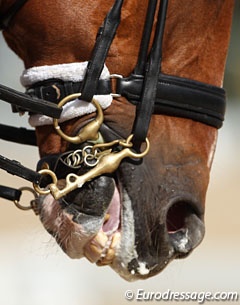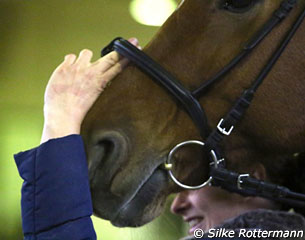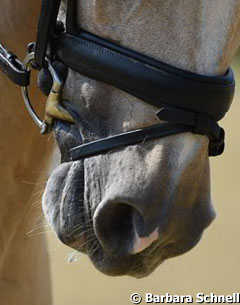
At the 2016 International Equitation Science Conference in Saumur, France, on 23 - 25 June 2016, researchers Doherty, Casey, McGreevy and Arkins presented their investigation into noseband tightness levels on competition horses. They measured noseband tightness in 750 horses competing in dressage, eventing and performance hunter classes internationally.
Forty four per cent of nosebands were extremely tight and only 7% were fitted to the recommended tightness level of the equivalent of two fingers. Tight nosebands may cause uncomfortable levels of pressure and pain in horses and are difficult to justify on welfare grounds.
Nosebands are used by riders to prevent the horse from opening its mouth, increase control and, in some cases, to comply with the rules of competition. Compared with standard cavesson nosebands, the crank noseband provides a mechanical advantage of 2, i.e. it doubles the tension for a given force used to tighten it. Possible negative consequences such as discomfort, pain or tissue damage are of concern to equine scientists and the public.
Their study sought to identify the level of noseband tightness applied to competition horses. Using the ISES taper gauge, noseband tightness data were collected from 750 horses competing in national and international competitions in eventing (n=354), dressage (n=334) and performance hunter (n=62) competitions in Ireland, England and Belgium.

Data were collected immediately before or after the performance. Using the taper gauge as a guide, results were classified according to the number of ‘fingers’ that could fit under the noseband at the nasal planum, and assigned to five groups: 2 fingers; 1.5 fingers; 1 finger; 0.5 fingers or zero fingers. Different tests were applied to compare noseband tightness levels between disciplines and horse age.
Seven per cent of nosebands were fitted to the recommended 2-finger noseband tightness level while the remainder had nosebands fastened tighter, with 44% fastening it too tight for even the tip of the taper gauge to be inserted beneath the noseband (zero fingers). Twenty-three per cent of nosebands were at 1 finger tightness and 19% at 1.5 fingers.
Significant differences emerged between disciplines with the highest levels of noseband tightness being among eventers, followed by dressage competitors with performance hunter classes being lowest. Horse ages ranged from 4 to 19 years. Noseband tightness did not differ significantly with age. Comparison of noseband tightness levels between four year old horses (n=80) and five year old horses (n=59) found slightly higher levels of noseband tightness in the five year old horses, but the difference was not significant.
 The prevalence of such tight nosebands aligns with the ISES position statement calling for the resumption of noseband checking and should trigger further research into the behavioural and physiological implications of tight noseband usage for horses. The current lack of guidelines and regulations regarding permitted noseband tightness levels permit the use of noseband tightness levels that may be detrimental to horse welfare.
The prevalence of such tight nosebands aligns with the ISES position statement calling for the resumption of noseband checking and should trigger further research into the behavioural and physiological implications of tight noseband usage for horses. The current lack of guidelines and regulations regarding permitted noseband tightness levels permit the use of noseband tightness levels that may be detrimental to horse welfare.
Source: ISES - Photos © Astrid Appels - Silke Rottermann - Barbara Schnell
Related Links
Noseband Special: Part I: The History of the Noseband
Noseband Special: Part II: The Purpose of the Noseband
Noseband Special: Part III: Riders and Trainers on Their Choice in Noseband
Noseband Special: Part IV: The Thicker, the Wider, the Better?
ISES Suggest to Empower FEI Stewards to Control Tightness of Noseband
Operant Riders Propose Six Major Rule Changes to Finnish Equestrian Federation to Benefit Horse Welfare
FEI Creates Working Group on FEI Officials